Aaditya K. Singh
Distinct Computations Emerge From Compositional Curricula in In-Context Learning
Jun 16, 2025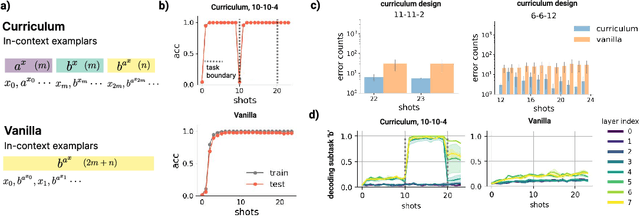
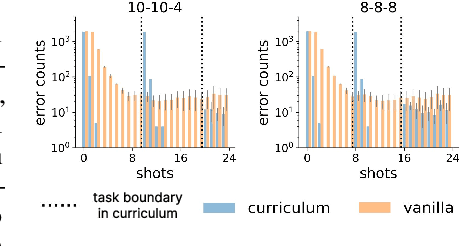

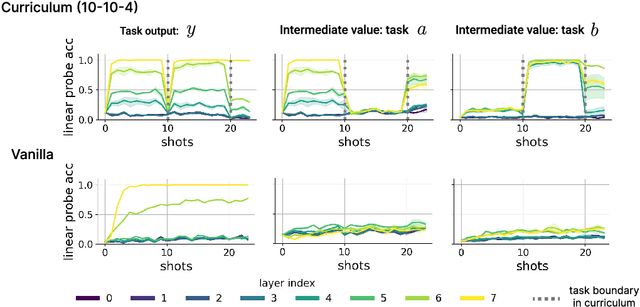
Abstract:In-context learning (ICL) research often considers learning a function in-context through a uniform sample of input-output pairs. Here, we investigate how presenting a compositional subtask curriculum in context may alter the computations a transformer learns. We design a compositional algorithmic task based on the modular exponential-a double exponential task composed of two single exponential subtasks and train transformer models to learn the task in-context. We compare (a) models trained using an in-context curriculum consisting of single exponential subtasks and, (b) models trained directly on the double exponential task without such a curriculum. We show that models trained with a subtask curriculum can perform zero-shot inference on unseen compositional tasks and are more robust given the same context length. We study how the task and subtasks are represented across the two training regimes. We find that the models employ diverse strategies modulated by the specific curriculum design.
Strategy Coopetition Explains the Emergence and Transience of In-Context Learning
Mar 07, 2025Abstract:In-context learning (ICL) is a powerful ability that emerges in transformer models, enabling them to learn from context without weight updates. Recent work has established emergent ICL as a transient phenomenon that can sometimes disappear after long training times. In this work, we sought a mechanistic understanding of these transient dynamics. Firstly, we find that, after the disappearance of ICL, the asymptotic strategy is a remarkable hybrid between in-weights and in-context learning, which we term "context-constrained in-weights learning" (CIWL). CIWL is in competition with ICL, and eventually replaces it as the dominant strategy of the model (thus leading to ICL transience). However, we also find that the two competing strategies actually share sub-circuits, which gives rise to cooperative dynamics as well. For example, in our setup, ICL is unable to emerge quickly on its own, and can only be enabled through the simultaneous slow development of asymptotic CIWL. CIWL thus both cooperates and competes with ICL, a phenomenon we term "strategy coopetition." We propose a minimal mathematical model that reproduces these key dynamics and interactions. Informed by this model, we were able to identify a setup where ICL is truly emergent and persistent.
Training Dynamics of In-Context Learning in Linear Attention
Jan 27, 2025Abstract:While attention-based models have demonstrated the remarkable ability of in-context learning, the theoretical understanding of how these models acquired this ability through gradient descent training is still preliminary. Towards answering this question, we study the gradient descent dynamics of multi-head linear self-attention trained for in-context linear regression. We examine two parametrizations of linear self-attention: one with the key and query weights merged as a single matrix (common in theoretical studies), and one with separate key and query matrices (closer to practical settings). For the merged parametrization, we show the training dynamics has two fixed points and the loss trajectory exhibits a single, abrupt drop. We derive an analytical time-course solution for a certain class of datasets and initialization. For the separate parametrization, we show the training dynamics has exponentially many fixed points and the loss exhibits saddle-to-saddle dynamics, which we reduce to scalar ordinary differential equations. During training, the model implements principal component regression in context with the number of principal components increasing over training time. Overall, we characterize how in-context learning abilities evolve during gradient descent training of linear attention, revealing dynamics of abrupt acquisition versus progressive improvements in models with different parametrizations.
HARP: A challenging human-annotated math reasoning benchmark
Dec 11, 2024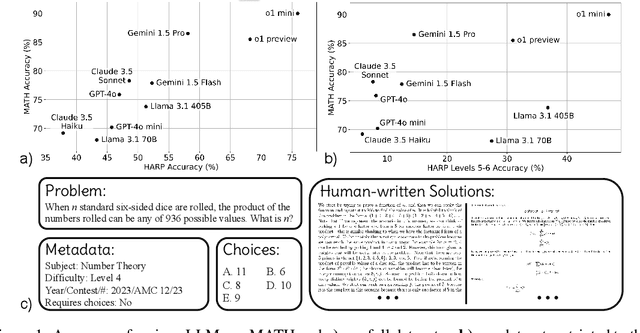

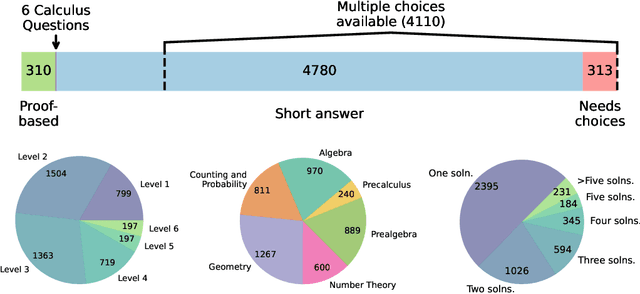

Abstract:Math reasoning is becoming an ever increasing area of focus as we scale large language models. However, even the previously-toughest evals like MATH are now close to saturated by frontier models (90.0% for o1-mini and 86.5% for Gemini 1.5 Pro). We introduce HARP, Human Annotated Reasoning Problems (for Math), consisting of 5,409 problems from the US national math competitions (A(J)HSME, AMC, AIME, USA(J)MO). Of these, 4,780 have answers that are automatically check-able (with libraries such as SymPy). These problems range six difficulty levels, with frontier models performing relatively poorly on the hardest bracket of 197 problems (average accuracy 41.1% for o1-mini, and 9.6% for Gemini 1.5 Pro). Our dataset also features multiple choices (for 4,110 problems) and an average of two human-written, ground-truth solutions per problem, offering new avenues of research that we explore briefly. We report evaluations for many frontier models and share some interesting analyses, such as demonstrating that frontier models across families intrinsically scale their inference-time compute for more difficult problems. Finally, we open source all code used for dataset construction (including scraping) and all code for evaluation (including answer checking) to enable future research at: https://github.com/aadityasingh/HARP.
The broader spectrum of in-context learning
Dec 05, 2024Abstract:The ability of language models to learn a task from a few examples in context has generated substantial interest. Here, we provide a perspective that situates this type of supervised few-shot learning within a much broader spectrum of meta-learned in-context learning. Indeed, we suggest that any distribution of sequences in which context non-trivially decreases loss on subsequent predictions can be interpreted as eliciting a kind of in-context learning. We suggest that this perspective helps to unify the broad set of in-context abilities that language models exhibit $\unicode{x2014}$ such as adapting to tasks from instructions or role play, or extrapolating time series. This perspective also sheds light on potential roots of in-context learning in lower-level processing of linguistic dependencies (e.g. coreference or parallel structures). Finally, taking this perspective highlights the importance of generalization, which we suggest can be studied along several dimensions: not only the ability to learn something novel, but also flexibility in learning from different presentations, and in applying what is learned. We discuss broader connections to past literature in meta-learning and goal-conditioned agents, and other perspectives on learning and adaptation. We close by suggesting that research on in-context learning should consider this broader spectrum of in-context capabilities and types of generalization.
Evaluation data contamination in LLMs: how do we measure it and (when) does it matter?
Nov 06, 2024
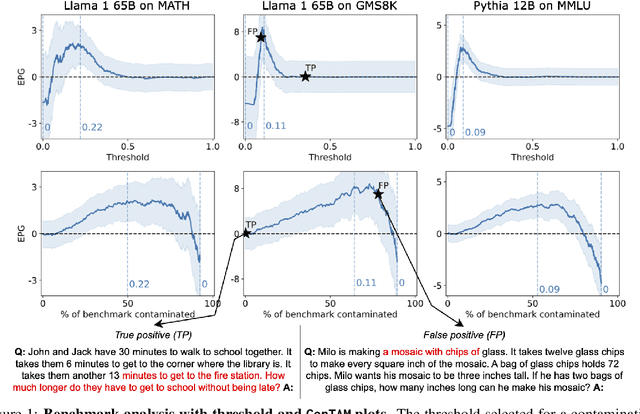
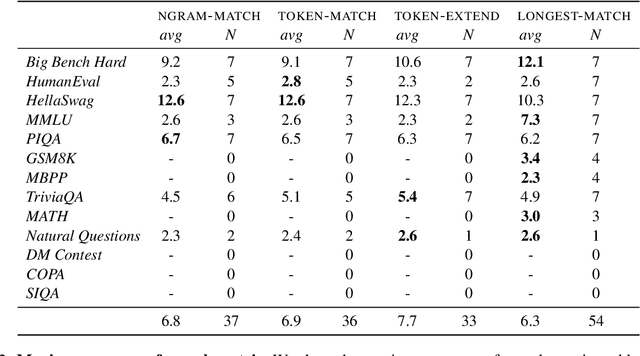
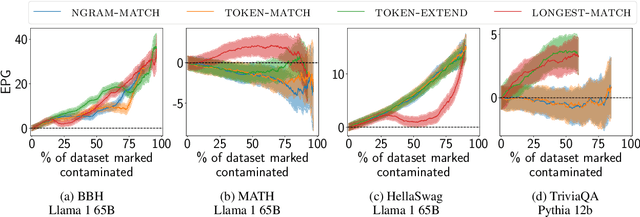
Abstract:Hampering the interpretation of benchmark scores, evaluation data contamination has become a growing concern in the evaluation of LLMs, and an active area of research studies its effects. While evaluation data contamination is easily understood intuitively, it is surprisingly difficult to define precisely which samples should be considered contaminated and, consequently, how it impacts benchmark scores. We propose that these questions should be addressed together and that contamination metrics can be assessed based on whether models benefit from the examples they mark contaminated. We propose a novel analysis method called ConTAM, and show with a large scale survey of existing and novel n-gram based contamination metrics across 13 benchmarks and 7 models from 2 different families that ConTAM can be used to better understand evaluation data contamination and its effects. We find that contamination may have a much larger effect than reported in recent LLM releases and benefits models differently at different scales. We also find that considering only the longest contaminated substring provides a better signal than considering a union of all contaminated substrings, and that doing model and benchmark specific threshold analysis greatly increases the specificity of the results. Lastly, we investigate the impact of hyperparameter choices, finding that, among other things, both using larger values of n and disregarding matches that are infrequent in the pre-training data lead to many false negatives. With ConTAM, we provide a method to empirically ground evaluation data contamination metrics in downstream effects. With our exploration, we shed light on how evaluation data contamination can impact LLMs and provide insight into the considerations important when doing contamination analysis. We end our paper by discussing these in more detail and providing concrete suggestions for future work.
Brevity is the soul of wit: Pruning long files for code generation
Jun 29, 2024


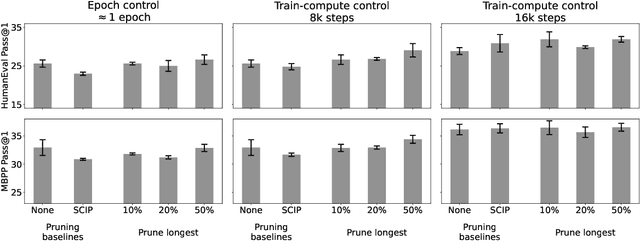
Abstract:Data curation is commonly considered a "secret-sauce" for LLM training, with higher quality data usually leading to better LLM performance. Given the scale of internet-scraped corpora, data pruning has become a larger and larger focus. Specifically, many have shown that de-duplicating data, or sub-selecting higher quality data, can lead to efficiency or performance improvements. Generally, three types of methods are used to filter internet-scale corpora: embedding-based, heuristic-based, and classifier-based. In this work, we contrast the former two in the domain of finetuning LLMs for code generation. We find that embedding-based methods are often confounded by length, and that a simple heuristic--pruning long files--outperforms other methods in compute-limited regimes. Our method can yield up to a 2x efficiency benefit in training (while matching performance) or a 3.5% absolute performance improvement on HumanEval (while matching compute). However, we find that perplexity on held-out long files can increase, begging the question of whether optimizing data mixtures for common coding benchmarks (HumanEval, MBPP) actually best serves downstream use cases. Overall, we hope our work builds useful intuitions about code data (specifically, the low quality of extremely long code files) provides a compelling heuristic-based method for data pruning, and brings to light questions in how we evaluate code generation models.
Quantifying Variance in Evaluation Benchmarks
Jun 14, 2024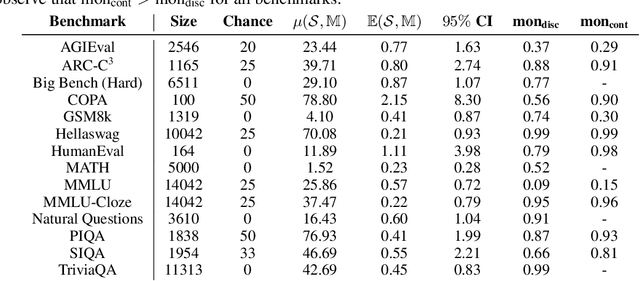
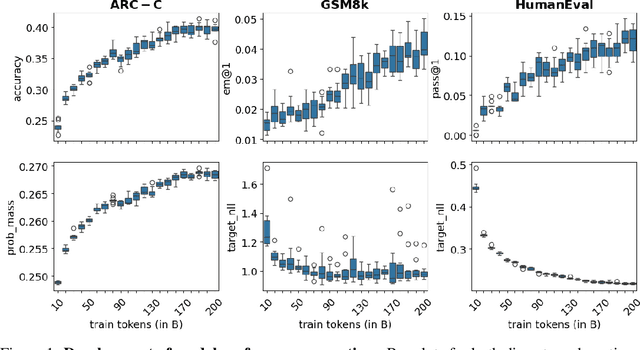

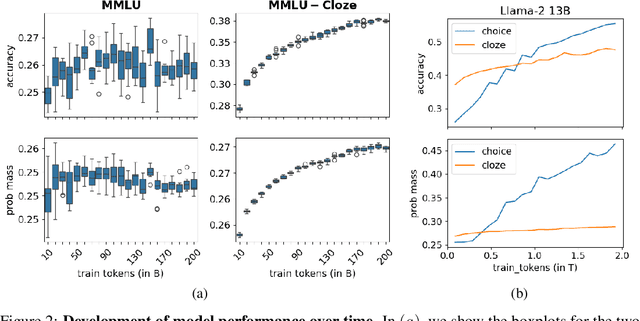
Abstract:Evaluation benchmarks are the cornerstone of measuring capabilities of large language models (LLMs), as well as driving progress in said capabilities. Originally designed to make claims about capabilities (or lack thereof) in fully pretrained models, evaluation benchmarks are now also extensively used to decide between various training choices. Despite this widespread usage, we rarely quantify the variance in our evaluation benchmarks, which dictates whether differences in performance are meaningful. Here, we define and measure a range of metrics geared towards measuring variance in evaluation benchmarks, including seed variance across initialisations, and monotonicity during training. By studying a large number of models -- both openly available and pretrained from scratch -- we provide empirical estimates for a variety of variance metrics, with considerations and recommendations for practitioners. We also evaluate the utility and tradeoffs of continuous versus discrete performance measures and explore options for better understanding and reducing this variance. We find that simple changes, such as framing choice tasks (like MMLU) as completion tasks, can often reduce variance for smaller scale ($\sim$7B) models, while more involved methods inspired from human testing literature (such as item analysis and item response theory) struggle to meaningfully reduce variance. Overall, our work provides insights into variance in evaluation benchmarks, suggests LM-specific techniques to reduce variance, and more generally encourages practitioners to carefully factor in variance when comparing models.
What needs to go right for an induction head? A mechanistic study of in-context learning circuits and their formation
Apr 10, 2024



Abstract:In-context learning is a powerful emergent ability in transformer models. Prior work in mechanistic interpretability has identified a circuit element that may be critical for in-context learning -- the induction head (IH), which performs a match-and-copy operation. During training of large transformers on natural language data, IHs emerge around the same time as a notable phase change in the loss. Despite the robust evidence for IHs and this interesting coincidence with the phase change, relatively little is known about the diversity and emergence dynamics of IHs. Why is there more than one IH, and how are they dependent on each other? Why do IHs appear all of a sudden, and what are the subcircuits that enable them to emerge? We answer these questions by studying IH emergence dynamics in a controlled setting by training on synthetic data. In doing so, we develop and share a novel optogenetics-inspired causal framework for modifying activations throughout training. Using this framework, we delineate the diverse and additive nature of IHs. By clamping subsets of activations throughout training, we then identify three underlying subcircuits that interact to drive IH formation, yielding the phase change. Furthermore, these subcircuits shed light on data-dependent properties of formation, such as phase change timing, already showing the promise of this more in-depth understanding of subcircuits that need to "go right" for an induction head.
Tokenization counts: the impact of tokenization on arithmetic in frontier LLMs
Feb 22, 2024



Abstract:Tokenization, the division of input text into input tokens, is an often overlooked aspect of the large language model (LLM) pipeline and could be the source of useful or harmful inductive biases. Historically, LLMs have relied on byte pair encoding, without care to specific input domains. With the increased use of LLMs for reasoning, various number-specific tokenization schemes have been adopted, with popular models like LLaMa and PaLM opting for single-digit tokenization while GPT-3.5 and GPT-4 have separate tokens for each 1-, 2-, and 3-digit numbers. In this work, we study the effect this choice has on numerical reasoning through the use of arithmetic tasks. We consider left-to-right and right-to-left tokenization for GPT-3.5 and -4, finding that right-to-left tokenization (enforced by comma separating numbers at inference time) leads to largely improved performance. Furthermore, we find that model errors when using standard left-to-right tokenization follow stereotyped error patterns, suggesting that model computations are systematic rather than approximate. We show that the model is able to convert between tokenizations easily, thus allowing chain-of-thought-inspired approaches to recover performance on left-to-right tokenized inputs. We also find the gap between tokenization directions decreases when models are scaled, possibly indicating that larger models are better able to override this tokenization-dependent inductive bias. In summary, our work performs the first study of how number tokenization choices lead to differences in model performance on arithmetic tasks, accompanied by a thorough analysis of error patterns. We hope this work inspires practitioners to more carefully ablate number tokenization-related choices when working towards general models of numerical reasoning.
 Add to Chrome
Add to Chrome Add to Firefox
Add to Firefox Add to Edge
Add to Edge